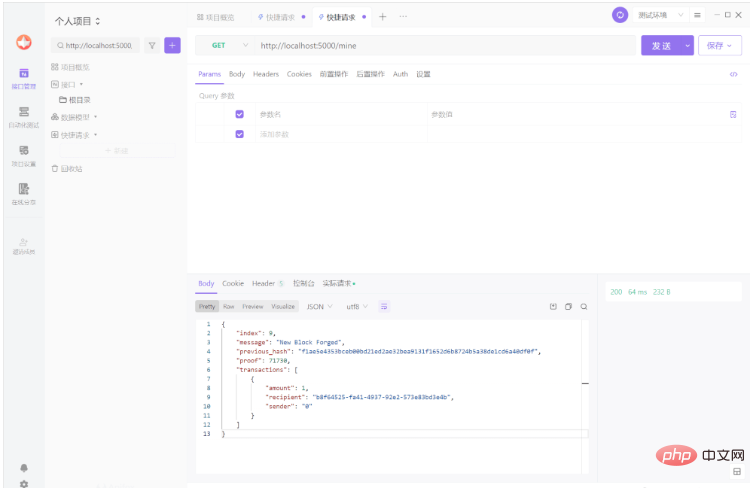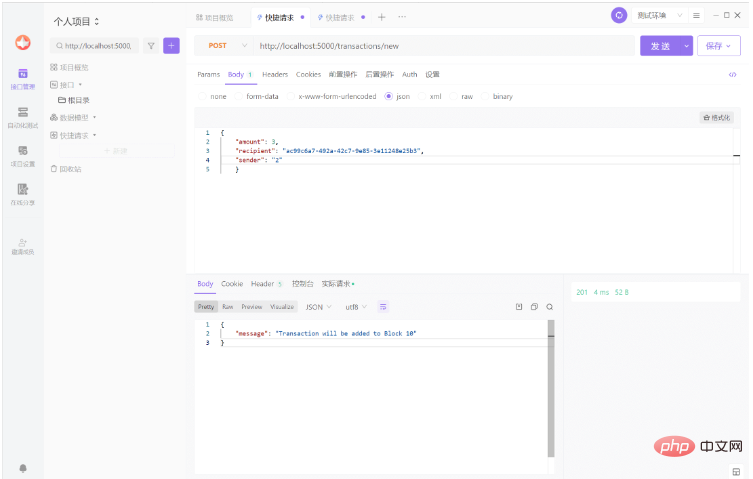區塊鏈是在電腦網路的節點之間共享資料的分類帳(分散式資料庫)。作為資料庫,區塊鏈以電子格式儲存資訊。區塊鏈的創新之處在於它保證了資料記錄的安全性和真實性,可信賴性(不需要沒有可信任的第三方)。
區塊鏈和典型資料庫的差異是資料結構。區塊鏈以block的方式收集資訊。
block是一種能永久記錄加密貨幣交易資料(或其他用途)的一種資料結構。類似於鍊錶。一個block記錄了一些火所有尚未被驗證的最新交易。驗證資料後,block將關閉,之後會建立一個新的block來輸入和驗證新的交易。因此,一旦寫入,永久不能更改和刪除。
block是區塊鏈中儲存和加密資訊的地方
##block由長數字標識,其中包括先前加密區塊的加密交易資訊和新的交易資訊
block以及其中的資訊必須由網路驗證
block = {
'index': 1,
'timestamp': 1506057125.900785,
'transactions': [
{
'sender': "8527147fe1f5426f9dd545de4b27ee00",
'recipient': "a77f5cdfa2934df3954a5c7c7da5df1f",
'amount': 5,
}
],
'proof': 324984774000,
'previous_hash': "2cf24dba5fb0a30e26e83b2ac5b9e29e1b161e5c1fa7425e73043362938b9824"
}BlockChain類,建構函式建立一個空列表來儲存區塊鏈,再創建一個空列表來儲存交易。創建block_chain.py
# block_chain.py
class Blockchain:
def __init__(self) -> None:
self.chain = []
self.current_transactions = []
def new_block(self):
# Creates a new Block and adds it to the chain
pass
def new_transaction(self):
# Adds a new transaction to the list of transactions
pass
@staticmethod
def hash(block):
# Hashes a Block
pass
@property
def last_block(self):
# Returns the last Block in the chain
passnew_transaction負責這個
class Blockchain(object):
...
def new_transaction(self, sender, recipient, amount) -> int:
self.current_transactions.append({
'sender': sender,
'recipient': recipient,
'amount': amount,
})
return self.last_block['index'] + 1new_transaction# 將交易加入到清單後,它傳回交易將會被加入的區塊的索引——下一個要挖掘的塊。這將在以後對提交交易的用戶有用。
import hashlib
import json
from time import time
class Blockchain:
def __init__(self) -> None:
self.chain = []
self.current_transactions = []
# Create the genesis block
self.new_block(previous_hash=1, proof=100)
def new_block(self, proof, previous_hash=None) -> dict:
block = {
'index': len(self.chain) + 1,
'timestamp': time(),
'transactions': self.current_transactions,
'proof': proof,
'previous_hash': previous_hash or self.hash(self.chain[-1]),
}
self.current_transactions = []
self.chain.append(block)
return block
def new_transaction(self, sender, recipient, amount) -> int:
self.current_transactions.append(
{
'sender': sender,
'recipient': recipient,
'amount': amount,
}
)
return self.last_block['index'] + 1
@property
def last_block(self) -> dict:
# Returns the last Block in the chain
return self.chain[-1]
@staticmethod
def hash(block) -> str:
block_string = json.dumps(block, sort_keys=True).encode()
return hashlib.sha256(block_string).hexdigest()class Blockchain(object):
def proof_of_work(self, last_proof) -> int:
proof = 0
while self.valid_proof(last_proof, proof) is False:
proof += 1
return proof
@staticmethod
def valid_proof(last_proof, proof) -> bool:
guess = f'{last_proof}{proof}'.encode()
guess_hash = hashlib.sha256(guess).hexdigest()
return guess_hash[:4] == '0000'Flask框架。
flask
pip install flask我們的伺服器將在我們的區塊鏈網路中形成單一節點,在同級目錄下建立一個
app.py:
from uuid import uuid4
from time import time
from textwrap import dedent
from flask import Flask, jsonify, request
from block_chain import Blockchain
# 实例化应用
app = Flask(__name__)
# 创建随机节点名称
node_identifier = str(uuid4()).replace('_', '')
# 实例化block_chain类
block_chain = Blockchain()
# 创建/mine端点
@app.route('/mine', methods=['GET'])
def mine():
block_chain.new_transaction(
sender="0",
recipient=node_identifier,
amount=1,
)
last_block = block_chain.last_block
last_proof = last_block['proof']
proof = block_chain.proof_of_work(last_proof)
previous_hash = block_chain.hash(last_block)
block = block_chain.new_block(proof, previous_hash)
response = {
'message': "New Block Forged",
'index': block['index'],
'transactions': block['transactions'],
'proof': block['proof'],
'previous_hash': block['previous_hash'],
}
return jsonify(response), 200
@app.route('/transactions/new', methods=['POST'])
def new_transaction():
return "We'll add a new transaction"
@app.route('/chain', methods=['GET'])
def full_chain():
response = {
'chain': block_chain.chain,
'length': len(block_chain.chain),
}
return jsonify(response), 200
# 修改端口号
if __name__ == '__main__':
app.run(host='0.0.0.0', port=5000)flask run ##透過api軟體(本次使用的是api fox)來傳送請求:

 註冊新節點
註冊新節點
...
from urllib.parse import urlparse
...
class Blockchain:
def __init__(self) -> None:
...
self.nodes = set()
...
def register_node(self, address) -> None:
parsed_url = urlparse(address)
self.nodes.add(parsed_url.netloc)衝突
...
import requests
class Blockchain:
...
def valid_chain(self, chain):
last_block = chain[0]
current_index = 1
while current_index < len(chain):
block = chain[current_index]
print(f'{last_block}')
print(f'{block}')
print("\n-----------\n")
# Check that the hash of the block is correct
if block['previous_hash'] != self.hash(last_block):
return False
# Check that the Proof of Work is correct
if not self.valid_proof(last_block['proof'], block['proof']):
return False
last_block = block
current_index += 1
return True
def resolve_conflicts(self):
"""
This is our Consensus Algorithm, it resolves conflicts
by replacing our chain with the longest one in the network.
:return: <bool> True if our chain was replaced, False if not
"""
neighbours = self.nodes
new_chain = None
# We're only looking for chains longer than ours
max_length = len(self.chain)
# Grab and verify the chains from all the nodes in our network
for node in neighbours:
response = requests.get(f'http://{node}/chain')
if response.status_code == 200:
length = response.json()['length']
chain = response.json()['chain']
# Check if the length is longer and the chain is valid
if length > max_length and self.valid_chain(chain):
max_length = length
new_chain = chain
# Replace our chain if we discovered a new, valid chain longer than ours
if new_chain:
self.chain = new_chain
return True
return False第一个方法 valid_chain() 负责通过遍历每个块并验证哈希和证明来检查链是否有效。resolve_conflicts() 是一种循环遍历我们所有相邻节点、下载它们的链并使用上述方法验证它们的方法。如果找到一个有效的链,其长度大于我们的,我们将替换我们的。
让我们将两个端点注册到我们的 API,一个用于添加相邻节点,另一个用于解决冲突:
@app.route('/nodes/register', methods=['POST'])
def register_nodes():
values = request.get_json()
nodes = values.get('nodes')
if nodes is None:
return "Error: Please supply a valid list of nodes", 400
for node in nodes:
blockchain.register_node(node)
response = {
'message': 'New nodes have been added',
'total_nodes': list(blockchain.nodes),
}
return jsonify(response), 201
@app.route('/nodes/resolve', methods=['GET'])
def consensus():
replaced = blockchain.resolve_conflicts()
if replaced:
response = {
'message': 'Our chain was replaced',
'new_chain': blockchain.chain
}
else:
response = {
'message': 'Our chain is authoritative',
'chain': blockchain.chain
}
return jsonify(response), 200在这一点上,如果你愿意,你可以拿一台不同的机器,并在你的网络上启动不同的节点。或者在同一台机器上使用不同的端口启动进程。比如创建两个端口5000和6000来进行尝试。
以上是Python如何建構區塊鏈的詳細內容。更多資訊請關注PHP中文網其他相關文章!




